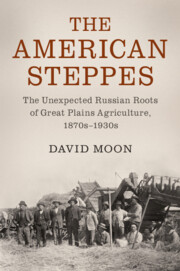Book contents
- The American Steppes
- Studies in Environment and History
- The American Steppes
- Copyright page
- Dedication
- Epigraph
- Contents
- Figures, Maps, and Tables
- Preface
- Acknowledgements
- Notes on the Text
- Dramatis Personae
- Abbreviations
- Maps
- Introduction
- Part I Contexts
- Part II Transfers
- Chapter 4 Wheat
- Chapter 5 Soil Science I
- Chapter 6 Soil Science II
- Chapter 7 Shelterbelts I
- Chapter 8 Shelterbelts II
- Chapter 9 Tumbleweed
- Conclusion
- Archival Collections Cited
- Index
Chapter 9 - Tumbleweed
from Part II - Transfers
Published online by Cambridge University Press: 23 March 2020
- The American Steppes
- Studies in Environment and History
- The American Steppes
- Copyright page
- Dedication
- Epigraph
- Contents
- Figures, Maps, and Tables
- Preface
- Acknowledgements
- Notes on the Text
- Dramatis Personae
- Abbreviations
- Maps
- Introduction
- Part I Contexts
- Part II Transfers
- Chapter 4 Wheat
- Chapter 5 Soil Science I
- Chapter 6 Soil Science II
- Chapter 7 Shelterbelts I
- Chapter 8 Shelterbelts II
- Chapter 9 Tumbleweed
- Conclusion
- Archival Collections Cited
- Index
Summary
The tumbleweed, or Russian thistle, has become an icon of the American West, celebrated in songs and movies. But, in reality it is an invasive species that causes great harm to other plants, animals, and humans. It thrives in dry conditions when other plants struggle. It was brought to the Great Plains from the steppes by mistake, in sacks of flax seed, by immigrants to South Dakota in the 1870s. It has defied attempts by agricultural scientists and state and federal government agencies to control or eliminate it.
- Type
- Chapter
- Information
- The American SteppesThe Unexpected Russian Roots of Great Plains Agriculture, 1870s–1930s, pp. 354 - 381Publisher: Cambridge University PressPrint publication year: 2020

